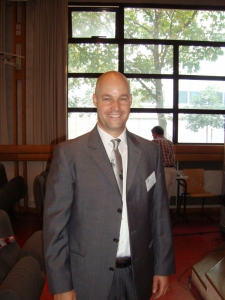ISYT Conference: Tsong kha pa blo bzang grags pa
ISYT Conference Day 2 continued
Back on day two of the ISYT conference, Elijah Ary (Ph.D., Harvard University) presented us with his study of the biographies of Tsong Kha pa blo bzang grags pa, entitled “From Disciple to Divinity: a shift in the figuration of Tsong kha pa blo bzang grags pa (1357-1419).”
 Dr. Ary described two distinct tendencies in dge lugs descriptions of Tsong kha pa. First, Tsong kha pa is described as a disciple of Mañjuśri who received teachings directly via visions or through a medium (his teacher dbu ma pa). Second, a later development, presents Tsong kha pa as a sprul pa of Mañjuśri. In this case, all his actions are to be described within the rubric of enlightened activity. As Mañjuśri, all the stories of Tsong kha pa’s meetings with Mañjuśri need to be explained, since Mañjuśri doesn’t need to appear to himself. Furthermore, some stories relate how Tsong kha pa could not understand Mañjuśri’s speech and needed a medium to translate for him. Ary found that there is some evidence for discomfort with viewing Tsong kha pa as an emanation of Mañjuśri even within the dge lugs tradition itself. Outside of the tradition, it has even been suggested that Tsong kha pa met with a demon pretending to be Mañjuśri (Gorampa’s claim). Ary explored the multiplicity of meaning in Tibetan Buddhism and the various traditional hermeneutical tools used to explain (away) various inconsistencies. The three main methods he mentioned are 1) to describe Tsong kha pa’s biographical information through how he appears to the viewer, either in terms of common or exclusive (thun mongs dang thun mongs ma yin pa) view; 2) through reference to relative and ultimate reality (kun rdzob bden pa dang don dam bden pa); and 3) through reference to the inability of normal beings to understand the intention of the acts of enlightened beings.
Dr. Ary described two distinct tendencies in dge lugs descriptions of Tsong kha pa. First, Tsong kha pa is described as a disciple of Mañjuśri who received teachings directly via visions or through a medium (his teacher dbu ma pa). Second, a later development, presents Tsong kha pa as a sprul pa of Mañjuśri. In this case, all his actions are to be described within the rubric of enlightened activity. As Mañjuśri, all the stories of Tsong kha pa’s meetings with Mañjuśri need to be explained, since Mañjuśri doesn’t need to appear to himself. Furthermore, some stories relate how Tsong kha pa could not understand Mañjuśri’s speech and needed a medium to translate for him. Ary found that there is some evidence for discomfort with viewing Tsong kha pa as an emanation of Mañjuśri even within the dge lugs tradition itself. Outside of the tradition, it has even been suggested that Tsong kha pa met with a demon pretending to be Mañjuśri (Gorampa’s claim). Ary explored the multiplicity of meaning in Tibetan Buddhism and the various traditional hermeneutical tools used to explain (away) various inconsistencies. The three main methods he mentioned are 1) to describe Tsong kha pa’s biographical information through how he appears to the viewer, either in terms of common or exclusive (thun mongs dang thun mongs ma yin pa) view; 2) through reference to relative and ultimate reality (kun rdzob bden pa dang don dam bden pa); and 3) through reference to the inability of normal beings to understand the intention of the acts of enlightened beings.
The key point that Elijah Ary made was that there is a clear temporal development observable in the biographies. The early biographies do not mention Tsong kha pa as Mañjuśri at all. Ary reports that in rtogs brjod rin po che ‘dun legs ma Tsong kha pa repeats the phrase “Thank you treasury of wisdom” (mkhyen pa’i gter) somewhere around twenty times, a reference to Mañjuśri, and presents himself as being guided by Mañjuśri. In Mkhas grub rje’s rje btsun bla ma tsong kha pa chen po’i ngo mtshar rmad du byung ba’i rnam par thar pa dad pa’i ‘jug ngogs there is an account of Tsong kha pa interacting with Mañjuśri in retreat, always through the medium of dbu ma pa. This story is always represented in this way in the early biographies, but later accounts have Tsong kha pa speaking directly to Mañjuśri without mediation. It is only later, specifically in biographies of Mkhas grub rje (14th or 15th c.), that Tsong kha pa is shown as an emanation of Mañjuśri. Tsong kha pa’s transformation seems to be related to the changing historical/social situation within the dge lugs tradition and their attempts at establishment of an identity and status for that tradition. It appears that Elijah Ary has gone through an amazing amount of biographies and related texts and has truly “done his homework” on studies of Tsong kha pa. I am sure we will see some interesting studies coming out of his research.

